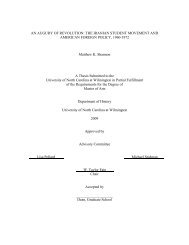Saprolegnia - The iLumina Digital Library
Saprolegnia - The iLumina Digital Library
Saprolegnia - The iLumina Digital Library
Create successful ePaper yourself
Turn your PDF publications into a flip-book with our unique Google optimized e-Paper software.
cells simple; long, cylindrical or tubular, rarely long-clavate; branched or unbranched;<br />
laterally appressed, rarely attached in a digitate fashion; persisting; fertilization tubes<br />
not observed.<br />
Aside from the members of <strong>Saprolegnia</strong> with ornamented oogonia, S. turfosa is<br />
one of the species of the genus that is most easy to recognize. <strong>The</strong> large, very shortstalked<br />
oogonia attended by androgynous antheridial branches each terminated by a<br />
long, tubular antheridial cell (Fig. 95 A) mark this species. <strong>Saprolegnia</strong> uliginosa also has<br />
short-stalked oogonia (Fig. 95 F) but its antheridial branches are frequently<br />
monoclinous (these are infrequent in S. turfosa).<br />
In view of the ease with which <strong>Saprolegnia</strong> turfosa can be recognized, its<br />
taxonomic history is surprisingly complicated. Seymour (1970:28, 29) reviewed the<br />
systematics of this species particularly thoroughly, and only a few additional comments<br />
are necessary. Reinsch (loc. cit.) was apparently the first to see S. turfosa, but chose not<br />
to name it. He (loc. cit., p. 311) referred to figure 15 on plate 17 as an illustration of<br />
<strong>Saprolegnia</strong> sp. 2, but this was an error; that figure depicts sporangia of a Gonapodya.<br />
Coker (1923) apparently had difficulty in recognizing S. turfosa, a situation which he<br />
corrected in his 1927 paper. It appears that A. Lund (1934) misidentified S. turfosa,<br />
equating it with Aplanes treleaseanus (see Achlya androgyna). He listed both S. treleaseana<br />
of Humphrey (1893) and Achlya treleaseana (Humphrey) Kauffman as synonyms of what<br />
is here recognized as S. turfosa. In addition, A. Lund (1934:21) also considered that<br />
Petersen’s S. paradoxa was synonymous with Aplanes treleaseanus; Petersen’s species, on<br />
the contrary, is conspecific with S. turfosa. It is very likely that the Aplanes turfosus<br />
reported from the Soviet Union by Morochkovs’kiĭ et al. (1967) was Achlya androgyna. In<br />
their account of the Russian material, papillate oogonia are described for the specimen<br />
they encountered.<br />
<strong>Saprolegnia</strong> turfosa is evidently not common (although it is widely distributed). In<br />
our experience, individuals appear most frequently in water or debris from Sphagnum<br />
spp. bogs. We have recovered S. turfosa repeatedly from acid waters (not bogs) in<br />
Norway and Sweden. A specimen collected on hempseed baited in a bog water sample<br />
from Norway was infected with Olpidiopsis saprolegniae var. saprolegniae.<br />
CONFIRMED RECORDS: -- CZECHOSLOVAKIA: Cejp (1959a:271, figs. 104,<br />
105). DENMARK: A. Lund (1934:20, fig. 7); Petersen (loc. cit.). GERMANY: Minden (loc.<br />
cit.); Reinsch (loc. cit.); Richter (1937:259, fig. 17). ICELAND: Howard et al. (1970: fig. 36).<br />
JAPAN: Kobayasi and Ookubo (loc. cit.). LAPLAND: Gäumann (loc. cit.). LATVIA:<br />
Apinis (1929a:227). UNITED STATES: Beneke (1948b:38, pl. 3); R. L. Butler (1975: figs.<br />
29-32); Coker (1923:79, pl. 20; loc. cit.); Kobayasi et al. (1967:10, pl. 14, fig. M; text fig. 3);<br />
Milanez (1966:110, pl. 12, fig. d; pl. 13); Milanez and Beneke (1968:19, pl. 2, fig. 10);<br />
Overman (1970:36); Seymour (1970:27, figs. 40-48); A. W. Ziegler (1948b:16, pl. 1, figs.1-<br />
9; 1952:13, pl. 5, fig. 4). USSR: Logvinenko and Meshcheryakova (1971: fig. 7).<br />
RECORDED COLLECTIONS: -- BRITISH ISLES: Dick (1962, 1963, 1966); Dick<br />
and Newby (1961). CANADA: Dick (1971c). CZECHOSLOVAKIA: Cejp (1931).<br />
614
















